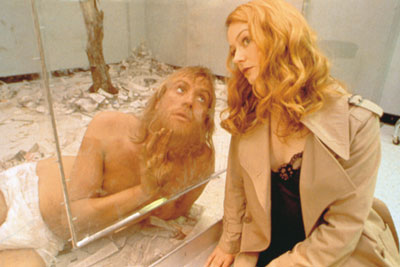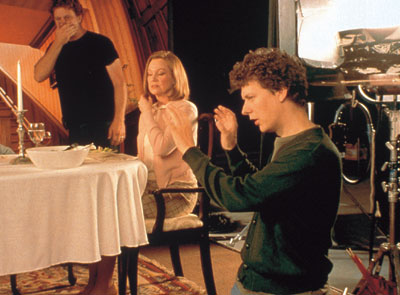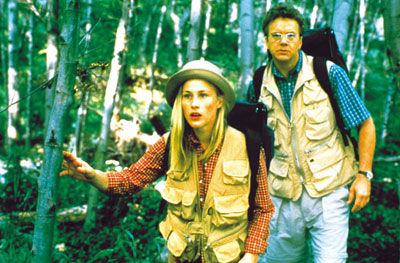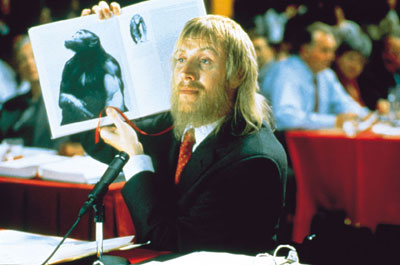WHERE THE WILD THINGS ARE
With a smart script by Charlie Kaufman, music-video whiz Michel Gondry steps onto the big screen with Human Nature.
By Chuck Stephens.
 |
| Rhys Ifans and Miranda Otto in Human Nature. |
Never wallow in the filth of instinct," is one of the moral lessons offered by celebrated music-video director Michel Gondry’s feature debut, Human Nature.
"Fuck Humanity," is another.
A comedy of flying fur wrapped around a tragedy of failed etiquette, Human Nature – written by Oscar-nominated Being John Malkovich scenarist Charlie Kaufman – adores contradictions. In the film, an excruciatingly repressed behavioral scientist (Tim Robbins) – with the world’s smallest penis attempts to teach table manners to mice, hoping to make the world a more civilized place. His romantic interest is a best-selling author (Patricia Arquette) who spent much of her young adulthood in a state of self-exile, living in the woods to cope with the fact that she is the world’s hairiest woman. Somehow, they’re "meeting in the middle" – until they happen upon a boy/man (Rhys Ifans) who’s been raised in the wilderness, and taught by his father to believe he’s an ape. What follows is an ingenious Moebius comic strip involving everything from a hot little French girl (Miranda Otto) who’s not French at all, a wardrobe’s worth of outrageous full-body hairpieces, a trip to heaven, a Congressional investigation and Rosie Perez.
As Being John Malkovich demonstrated, Kaufman’s got a remarkable gift for posing complex ontological dilemmas as perverted puppet dramas, and place sexual urges in narrative riddles only a Sphinx could out-think – qualities which make him a natural fit with the Parisian Gondry.
Best known for his technically dazzling videos for performers like Björk, Beck and Radiohead, Gondry has a mad scientist’s knack for fusing hi-tech image-morphing with old-school camera crafts like back projection. His work features exquisite stagecraft (gorgeously artificial forest settings are his forte) and a sense of impossible visual perspective that even M.C. Escher might admire. But what makes Gondry’s videos and television commercials (for Smirnoff, Levi’s and The Gap) truly memorable isn’t just their remarkable visual dazzle, but the way their micro-narratives often depict all-too-adult anxieties, such as failure and helplessness, in the giant-sized terms of a children’s nightmare. In Human Nature, women make monkeys of themselves, scientists contemplate the relative values of size and sound (his wee-wee vs. her "oui, oui"), and a magical creature named Puss frolics in the awful mist of civilization – and realizes he’s been barking up the wrong tree.
Chuck Stephens speaks with Michel Gondry, who’s just finished a new commercial for Gatorade, about mainstream movies, maddening methodologies, and the sentimental geometry of it all.
 |
| Director Michel Gondry on set. |
FILMMAKER: One of the big challenges directors who come to feature filmmaking from music video always seem to face is the need to develop characters who have a greater depth than they might in an three-minute-long piece of work. Was that true for you in making Human Nature?
MICHEL GONDRY: Yes, it was something new, even though, especially with [musicians] like Björk, we would always talk in depth about the characters she’d play. Especially in something like "Bachelorette," where she’d act like... well, not really like herself, but she would include a lot of elements from her life in the character. That was the main difference in shifting to longer-form work: to create somebody really alive, to create the life of somebody, and to work with the layers of the character that were on the paper already. You can play lines and characters in so many different ways.
FILMMAKER: Was there a particular actor in Human Nature who you found especially satisfying to work with in terms of developing his or her character?
GONDRY: Rhys Ifans – he had a very intelligent take on his part which most of the actors we looked at for the role didn’t seem to have. He took Puff very seriously, and he found a purity, not a cynicism, in him. We needed somebody to point out Puff’s childlike character; everybody else wanted to make him very animalistic and physical. Rhys took the opposite approach: he made him very human.
FILMMAKER: Was keeping cynicism and sarcasm out of the character, and out of the film in general, a major concern?
GONDRY: That was something I really wanted to avoid, because, for one thing, a lot of directors are very good at doing that. I see myself more as having a kind of naiveté that I wanted to use in this movie. I would always try to put myself in the positions of these characters and to see what would happen with my emotions. And I always tried to stay on an emotional level, even though I didn’t want [the film] to be too romantic or too sentimental. A true emotion isn’t necessarily sentimental at all.
FILMMAKER: A lot of your work has this tension between something childlike or innocent, and an expression of darker fears that are somehow very grown-up and evolved. Was this sensibility something you brought to the film, or was it already there in the script?
GONDRY: I think the script was very similar to ideas I’d worked with before, and I tried to emphasize those qualities in Human Nature. It could definitely have been directed in a more cynical way. Not that that was Charlie [Kaufman]’s view, because I don’t think he’s cynical at all. I think he’s trying to resist the Hollywood movie concept – the movie with a happy ending where everybody can understand the characters. After having tried to resist [this approach], I think the [resulting] film could easily have ended up seeming cynical. But I was trying to see what was true in what he had written, rather than the things that might have seemed to be there just as a way to be "independent" – which is not at all what I wanted. It doesn’t bother me to be mainstream.
FILMMAKER: It doesn’t bother you?
GONDRY: No, not at all. When people are very original, sometimes they are original as a way to resist the mainstream. I saw my job as figuring out what the material should be, because I don’t necessarily need to resist the mainstream. I just wanted to see what was totally original in the script, and, I have to say, I didn’t change much of it.
FILMMAKER: That’s remarkable, since so many of the images and ideas in the film seem related to your other work: the idea of stories within stories and boxes within boxes, for one thing, but there are also certain visual motifs and ideas that seem to be rather direct quotes from some of your videos. The toy-cabin-in-the-woods idea, for example, is something from one of your Björk videos.
 |
| Patricia Arquette and Tim Robbins in Human Nature. |
GONDRY: Yes, and I guess when I read the script I felt at home for this reason – those sorts of ideas and images were all there already. Maybe when Charlie Kaufman watched my reel, with all my videos, he felt at home as well, because it’s true, we have a lot of ideas in common. I had even made a short film years ago with people entering other people’s minds. It was done in a totally different way than what he did with Spike Jonze in Being John Malkovich, but I had this concept as well. I think the first thing I liked about his writing was his use of geometry – the geometrical notion of his storytelling: how he interweaves the characters, and how he’s able to keep creating original turns throughout the story.
FILMMAKER: Can you explain this "geometrical notion of storytelling" a little more?
GONDRY: If you go to work, and at the end of work, you return to where you parked your car – that’s simple. But you also might find a path that will walk you across a mountain to another little path that leads to a new road, which then leads you back to your car in a new way. This, to me, is satisfying, because I have created a loop. When I read a story, it can be really linear and basic, or it can use some path which will create a geometrical pattern. For example, in "Bachelorette," it’s a spiral: it’s a story in a story in a story, and each time the elements of the story repeat themselves, they get smaller and smaller and smaller, like a spiral. When I did a video for Ciba Matto, the pattern I used was a palindrome, so the story would go forward and backward at the same time, and it would meet in the middle. I think that Charlie, in his writing, has some of these preoccupations, too. Like in Being John Malkovich, you have four people, and they can go into the mind of another person. So the first person invites a second one to go into the same mind, and then through that mind, they begin to interact with the body of a third person – all those sorts of geometrical patterns are really satisfying to my brain. But they’re hard to explain, and I think most people don’t really care for that kind of thing. But to me it’s really satisfying, like the Moebius ribbon.
FILMMAKER: The Moebius strip?
GONDRY: Yes. I also like a certain type of sport because it creates a geometrical pattern on the ground, and I don’t like sports when they’re only linear. Like in soccer or basketball, the players create patterns as they interact with each other, passing the ball and so on. A lot of my interests in these things comes from the fact that I was not great at expressing my feelings or my self through words as a child, and my brain just developed in more visual and geometrical ways. Even today, if I want to remember a telephone number, I have to look into the shape of the numbers, because I remember the pattern I do with my finger, but I can’t remember the numbers themselves.
FILMMAKER: You made a short film a couple of years ago called The Letter, which seemed really quite different from your music videos. Was that film a kind of trial run for making a feature like Human Nature?
GONDRY: No, not really. I’ve always tried to make little stories in my videos, though I’m not sure it shows up every time, but always I always try to have a beginning, middle and "the End." I don’t want to just accumulate a succession of impactful images. I’m always interested in storytelling.
FILMMAKER: You say you’re not so much interested in making films or videos that are just a series of impactful images, but you’ve nevertheless made some amazing images by stretching the possibilities of the technologies involved. Do you have a favorite image or type of effect that you’ve pioneered?
GONDRY: That’s hard to answer. If I find a new technique, there is a great excitement to see this idea going from my brain into realization. For example, we did this effect for the Rolling Stones video – actually two effects. The first was the frozen-time effect, like the one they used in The Matrix, but the other effect has not been done so many times, because it’s not so narrative and it’s very weird. It’s like this morphing between all the stages of images, and it gives an effect like moving through a very thick ether. When we saw the first result, we were all so amazed that we screamed. There was such excitement. I guess it’s pretentious to say, but it was like when [the first film audience] saw [that image of a] train arriving at the train station – how they screamed! Trying to reach new points like that all the time, it’s really thrilling. But there’s also a kind of technical aspect to those discoveries which is not purely visual to me. It’s like trying to figure out a new way to do a process, to come up with an idea that will do something you’ve never seen before. It’s not like opening a book and reproducing a still photograph that’s there already. But to be a real inventor or a real discoverer now... I couldn’t do it, because I don’t have enough knowledge in psychology and science and chemistry. But I do like to be creative and invent stuff, just the same as when I was child playing with Lego. Using animation and camera techniques is my way to do that. I wish I was the guy who invented the airplane!
 |
| Rhys Ifans in Human Nature. |
FILMMAKER: There’s always something quite beautiful, and often quite touching, in your work. I know you want to keep away from the idea of sentimentality, but there’s something true about the sentiments in your work.
GONDRY: I’m very pleased if you believe that, and if it’s true, then I feel I’ve really achieved something. As sentimentality is concerned, though, please don’t misunderstand – I like broad movies. I like to cry in movies. My favorite director is Chaplin. I’m totally touched by what you’re saying, but when I was talking about sentimentality before, I was talking about not wanting to have the feeling that I’m being manipulated by the director or the producer to reach a level of emotion. But for me, if a sentiment comes from a true place, then it’s great. But if it’s there just to force an emotion in people, I don’t think that’s so great.
FILMMAKER: There’s something very old-fashioned about a lot of your inspirations, and about your way of working, too. For instance, there really aren’t a tremendous number of digital effects in Human Nature, are there?
GONDRY: No, and that’s the way I wanted it. I had read many scripts before I found this one. [The others] would have required a lot of FX to fix a weak story. I preferred to not do effects and have a strong story, even if it meant I had less money to work with. There are so many effects that you can do, using those old camera techniques like back projection, that are so much more economical than the digital, and much more satisfying as well, because they are very organic and filmic. There are still many good reasons to use those old techniques without being old-fashioned.
FILMMAKER: You’ve been involved in some expensive videos in the past; how expensive did they get?
GONDRY: I think on the Rolling Stones video we spent about a million dollars, and I did one for Sheryl Crow which was quite expensive, about $800,000. But that’s my maximum. "Bachelorette" was made for about $400,000, something like that.
FILMMAKER: The video you made for the Foo Fighters, "Everlong" – the one where Dave Grohl keeps trying to wake up from a nightmare about two grotesque, cabin-invading Teddy Boys – is my personal favorite.
GONDRY: It’s funny you say that, because one day I will write my own script for a feature, and that will be the kind of movie I will do. That kind of grotesque, childlike and anguished universe is something I feel personally attached too and would like to develop on my own. That’s the video that probably reflects my own personality the most.
FILMMAKER: There’s something about it that reminds me of the work of early comic strip artists, or old cartoons...
GONDRY: Yes, especially cartoons like Felix the Cat, of even the early Mickey Mouse cartoons, which are amazing and really close to Surrealism. I remember one Mickey Mouse cartoon where he’s trying to dance with Minnie, but his feet keep getting bigger and bigger, and he keeps smashing her feet. It has this really great, nightmarish feeling – like something you really feel deeply inside. I’m a huge fan of Tex Avery, too; I think his stories are deeply buried in each one of our guts. It’s really a kind of relief when you watch them; it’s like screaming. He expresses with humor the painful feelings you have all the time. He explains madness too, in a way – especially in one of his cartoons where Droopy is chasing a wolf, and the wolf is trying to escape from him. He’s running, he’s taking a boat, taking a train, taking a plane when he finally arrives somewhere, Droopy is there already. That’s really something you feel deep inside, a kind of dread that words can’t exactly explain.
FILMMAKER: And Jerry Lewis, how do you feel about Jerry Lewis?
GONDRY: What do you mean?! I’m French – of course I love him, too!
FILMMAKER: Naturellement! Do you have a next project ready to go?
GONDRY: Yes; it’s also from a script that Charlie wrote, and it’s again very geometrical. It’s about a guy who wants to erase his girlfriend from his memory. You get to see their relationship erased scene by scene, and then in the middle of the process, he changes his mind and decides to save her. So he takes her out of the memories she belongs in, and puts her in memories she doesn’t belong in, to try and hide her. It’s very symmetrical, but very romantic as well.
VOD CALENDAR


 See the VOD Calendar →
See the VOD Calendar →


